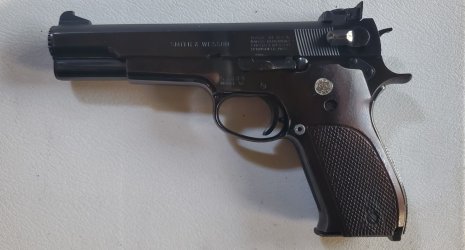I think many of us realize that there were two key differences between the original S&W Model 52 pistol and the 52-1 pistol. (If there are more than two, please share them!)
The 52-1 had the frame adorned with a rail specifically to wear the accessory counter weight that S&W offered.
But the other difference is more significant — the shape and contour of the trigger of the no-dash 52 is different than the 52-1 (and the 52-2 for that matter) but it is more than just the physical shape.
The original Model 52 is actually a double action capable pistol.
And here is the subject of this thread… the modern mystery of the double action Model 52!
I have read where there is an internal lock-out device to prevent the pistol from actually being capable of a double action first shot. And indeed, nearly every picture that's ever been shared or captured of a no-dash 52 shows the trigger far back in the guard, ready for single action work but only for that.

Doesn't that look simply odd? Any long time admirers of the 52 want to admit they have never seen this strange oddity?
I saved that picture from a Gunbroker auction that ran nearly a decade ago! If you have never seen a 52 look quite like that… well, welcome to the party.
I've never seen one out in the world with the double action activated. And being that I have never owned a no-dash 52, I have also never seen the inner workings that show where this mysterious "lock out" device is located or how it works.
Now who amongst us -HAS- seen this? Who has a no-dash 52 and uses the double action setting?
Is it particularly difficult to lock out the double action? I have heard it mention that this task can be fussy… but on that, I have zero experience.
This subject seems to be nearly untouched. I don't think I have ever seen it discussed here.
The 52-1 had the frame adorned with a rail specifically to wear the accessory counter weight that S&W offered.
But the other difference is more significant — the shape and contour of the trigger of the no-dash 52 is different than the 52-1 (and the 52-2 for that matter) but it is more than just the physical shape.
The original Model 52 is actually a double action capable pistol.
And here is the subject of this thread… the modern mystery of the double action Model 52!
I have read where there is an internal lock-out device to prevent the pistol from actually being capable of a double action first shot. And indeed, nearly every picture that's ever been shared or captured of a no-dash 52 shows the trigger far back in the guard, ready for single action work but only for that.

Doesn't that look simply odd? Any long time admirers of the 52 want to admit they have never seen this strange oddity?
I saved that picture from a Gunbroker auction that ran nearly a decade ago! If you have never seen a 52 look quite like that… well, welcome to the party.
I've never seen one out in the world with the double action activated. And being that I have never owned a no-dash 52, I have also never seen the inner workings that show where this mysterious "lock out" device is located or how it works.
Now who amongst us -HAS- seen this? Who has a no-dash 52 and uses the double action setting?
Is it particularly difficult to lock out the double action? I have heard it mention that this task can be fussy… but on that, I have zero experience.
This subject seems to be nearly untouched. I don't think I have ever seen it discussed here.



